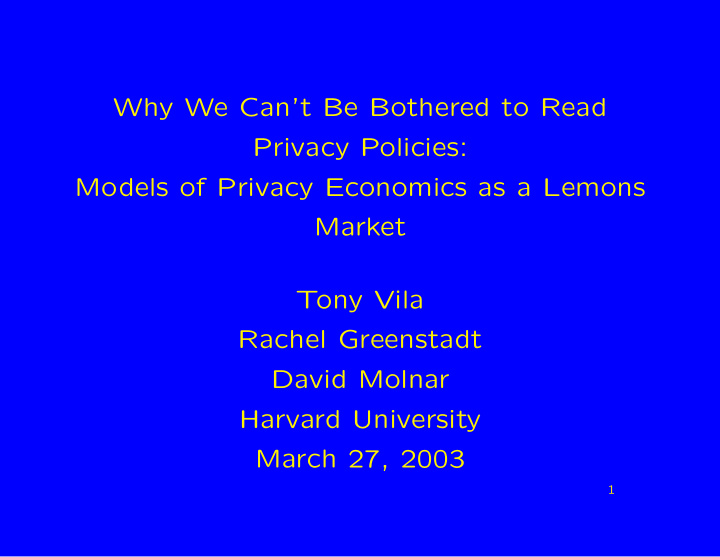



Why We Can’t Be Bothered to Read Privacy Policies: Models of Privacy Economics as a Lemons Market Tony Vila Rachel Greenstadt David Molnar Harvard University March 27, 2003 1
Motivation • People claim to have high values for privacy • However, there is a privacy problem on the internet • Asymmetric information 2
Privacy as a Lemons’ Market • Akherhof modelled markets with asymmetric information (used cars) • Nobody knows which items are “good” (respect privacy), so people willing to pay less • Good agents are not willing to receive lower compensation and are driven out of the market • Result: all cars are lemons, no privacy on the internet 3
Signaling Signals for privacy • Privacy policies • P3P • trust seals • reputation 4
Testing • Signals can be hard to interpret, cost for testing (reading policies, discussion, reputation, etc) • Consider average cost of testing of all sites as you have to decide whether to test before you test ( T a ) • Put into the payoff matrix, calculate utility 5
So what happens when this cost T enters the traditional sig- nalling payoff matrix? Allow for the variables representing: B = the benefit the consumer gets from a transaction T = the cost to test for the consumer V = the cost for the consumer of having their privacy violated P = the benefit the firm gets from the transaction S = the cost to the firm to send the signal guaranteeing privacy I = the benefit the firm gets from selling the consumer’s personal information. Respects Defects − T, 0 Tests B − T, P − S Doesn ′ t B − V, P + I B, P − S Can now find the utility of testing 6
Results Consider probability of testing q • UNSTABLE - q approaches 1, all consumers test, strong incentive to protect privacy, q approaches 0, no consumers test, no incentive. • When firms respect privacy, no consumers test • When no consumers test, all firms disrespect information • When firms disrespect privacy, consumers start to test • When all consumers test, firms respect, infinite loop 7
Some evidence for this, people started to pay attention to privacy in late 1990s because lots of abuse, results you see proliferation of privacy policies, 2002 survey shows improvement in Fair In- formation Practices (where we are in cycle is uncertain) 8
Conclusions • No perfect market for all firms respect privacy • Eventual equilibrium for probabilities p and q , the prob that orgs respect privacy, and the prob that consumers test • BUT - the organizations can affect the price of testing (by using uniform standards or writing obtuse policies), so the equilibrium point is also unstable and is affected by new or- ganizations entering the market. 9
Recommend
More recommend